Add this eBook to your basket to receive access to all 369 records. Our indexes include entries for the spelling shea. In the period you have requested, we have the following 369 records (displaying 161 to 170): These sample scans are from the original record. You will get scans of the full pages or articles where the surname you searched for has been found. Your web browser may prevent the sample windows from opening; in this case please change your browser settings to allow pop-up windows from this site. Dublin Electors
(1865)
This alphabetical list of electors for the City of Dublin for 1865 is annotated with details of the votes cast in the election of 15 July 1865 for a member of Parliament. The candidates were John Vance, Esq., D. L. (V), Benjamin Lee Guinness, Esq., D. L., LL. D. (G), and Jonathan Pim, Esq. (P). The first column gives, in bold, the initial of the ward in which lay the property that was the elector's qualification. The second column gives the elector's sequential number (alphabetically) within that ward. Then the elector's full name is given, surname first, and address, usually including house number. The votes cast are shown on the right: where these columns are blank, the elector did not vote. The key to the ward names is: A, South Dock; B, Donnybrook; C, Rathdown; D, Trinity; E, South City; F, Royal Exchange; G, Mansion House; H, Fitzwilliam; I, Wood Quay; K, Merchants' Quay; L, Usher's Quay; M, Arran Quay; N, Inns' Quay; O, North City; P, Rotundo; Q, Mountjoy; R; North Dock. S indicates the register of freemen. | Sample scan, click to enlarge

| Dublin University Electors
(1868)
The roll of all persons entitled to vote at elections for members to serve in Parliament for the University of Dublin lists living graduates of the university, arranged alphabetically by surname and christian name(s), with current residence, dates at which their degrees were conferred - Vern. denoting the Spring, Aest. the Summer, and Hiem. the Winter Commencements - and date of registration. Members of the Senate and electors on the books of Trinity College are distinguished by a dagger. Where an elector's name is given in italics, he was no longer known at the residence given. | Sample scan, click to enlarge

| Patentees of New Inventions
(1869)
Index of patentees and applicants for patents of inventions in 1869: giving full name of patentee (surname first); number of patent (in bold); date (within 1869); and subject-matter. Where the patentee was acting as agent for third parties, their names are given in italics in the subject-matter column. | Sample scan, click to enlarge

| Science Schools and Classes: Elementary Examination: Class Lists
(1869)
The Science and Art Department of the Committee of Council on Education published these class lists giving the names of all the successful candidates in the examination of science schools and classes taken in May 1869. The candidates were of three levels: honours; second stage or advanced examination; third stage or elementary examination. Twenty-three subjects were offered. These are the lists for the elementary examination. The tables, arranged subject by subject, give the candidate's full name (surname first), age, and occupation - or, in the case of those not yet of working age, father's occupation, preceded by (f.). Many candidates sat and were successful in more than one subject, and so appear in more than one list. The subjects are: I. Practical, Plane and Solid Geometry; II. Machine Construction; III. Building Construction; IV. Elementary Mathematics; V. Higher Mathematics; VI. Theoretical Mechanics; VII. Applied Mechanics; VIII. Acoustics, Light, and Heat: IX. Magnetism and Electricity; X. Inorganic Chemistry; XI. Organic Chemistry; XII. Geology; XIII. Mineralogy; XIV. Animal Physiology; XV. Zoology; XVI. Vegetable Anatomy and Physiology; XVII. Systematic and Economic Botany; XVIII. Mining; XIX. Metallurgy; XX. Navigation; XXI. Nautical Astronomy; XXII. Steam; XXIII. Physical Geography. | Sample scan, click to enlarge

|  Men of the 57th Regiment who fought in the New Zealand War
(1860-1870) Men of the 57th Regiment who fought in the New Zealand War
(1860-1870)
New Zealand War Medal roll for the 57th (The West Middlesex) Regiment of Foot: for service in the New Zealand campaign 1863 to 1867: the rolls were compiled following a general order in 1869 and the medals were distributed in 1870. The regiment had been serving at Poonah in India, and was moved to New Zealand in November 1860; the men returned to England in April 1867. | Sample scan, click to enlarge

|  Outstanding soldiers of the 106th regiment of Foot
(1860-1870) Outstanding soldiers of the 106th regiment of Foot
(1860-1870)
The 2nd Bombay European Light Infantry was renamed the 106th (Bombay) Light Infantry in 1861. The regiment moved from Bombay to Neemuch in 1861; to Nusseerabad in 1864; to Meean Meer in 1867; to Umballa in 1868; and to Jhansi and Nowgong in 1870. Each year just a handful of outstanding soldiers of the regiment were chosen for good conduct medals and gratuities: these are listed here. There were two lists, one for men recommended for the Good Conduct Medal without a gratuity, and one for gratuities - £5 to a private, £10 to a corporal, and £15 to a serjeant. Both lists are indexed here, and each gives rank, name, regimental number, date of recommendation and date of issue. (The sample scan is from the 105th foot) | Sample scan, click to enlarge
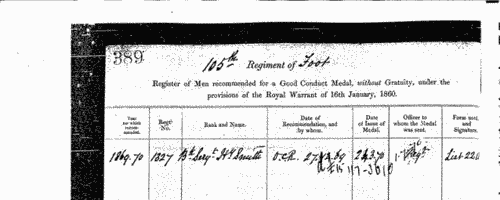
|  Outstanding soldiers of the 109th regiment of Foot
(1860-1870) Outstanding soldiers of the 109th regiment of Foot
(1860-1870)
The 3rd Bombay European Regiment was renamed the 109th (Bombay Infantry) Regiment in 1862. In 1860 it was based at Kurrachee; but was moved to Aden in 1864; and then back to India in 1866. Each year just a handful of outstanding soldiers of the regiment were chosen for good conduct medals and gratuities: these are listed here. There were two lists, one for men recommended for the Good Conduct Medal without a gratuity, and one for gratuities - £5 to a private, £10 to a corporal, and £15 to a serjeant. Both lists are indexed here, and each gives rank, name, regimental number, date of recommendation and date of issue. (The sample scan is from the 105th foot) | Sample scan, click to enlarge
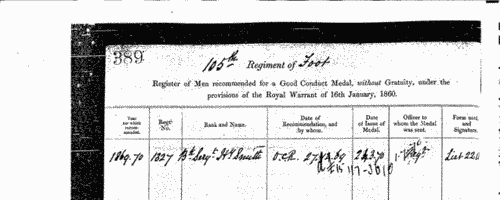
|  Outstanding soldiers of the 10th regiment of Foot
(1860-1870) Outstanding soldiers of the 10th regiment of Foot
(1860-1870)
The 10th (The North Lincolnshire) Regiment of Foot was in two battalions. The 1st battalion returned from India in 1859, and in 1860 was at Plymouth. The home depot was at Devonport. The second battalion was sent abroad in 1859, and by 1860 was serving at the Cape of Good Hope: it was transferred to India in 1864. Each year just a handful of outstanding soldiers of the regiment were chosen for good conduct medals and gratuities: these are listed here. There were two lists, one for men recommended for the Good Conduct Medal without a gratuity, and one for gratuities - £5 to a private, £10 to a corporal, and £15 to a serjeant. Both lists are indexed here, and each gives rank, name, regimental number, date of recommendation and date of issue. (The sample scan is from the 105th foot) | Sample scan, click to enlarge
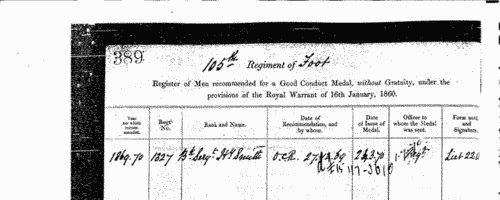
|  Outstanding soldiers of the 14th regiment of Hussars
(1860-1870) Outstanding soldiers of the 14th regiment of Hussars
(1860-1870)
The 14th (The King's) Regiment of Light Dragoons or Hussars embarked for India in 1841, and served at Kirkee, Bombay. The home depot was at Maidstone. Each year just a handful of outstanding soldiers of the regiment were chosen for good conduct medals and gratuities: these are listed here. There were two lists, one for men recommended for the Good Conduct Medal without a gratuity, and one for gratuities - £5 to a private, £10 to a corporal, and £15 to a serjeant. Both lists are indexed here, and each gives rank, name, regimental number, date of recommendation and date of issue. (The sample scan is from the 105th foot) | Sample scan, click to enlarge
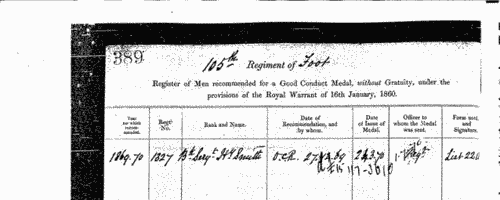
|  Outstanding soldiers of the 15th regiment of Foot
(1860-1870) Outstanding soldiers of the 15th regiment of Foot
(1860-1870)
The 15th (The Yorkshire East Riding) Regiment of Foot was in two battalions. The 1st battalion returned from Gibraltar in 1857. The home depot was at Pembroke, and in 1860 they were serving on Jersey; in that year the battalion was transferred to Ireland; to North America in 1862; to Bermuda in 1868; and back to Ireland in 1870. The second battalion was raised in England in 1858, and was sent to Malta; in 1863 to Gibraltar; and in 1868 to Ireland. Each year just a handful of outstanding soldiers of the regiment were chosen for good conduct medals and gratuities: these are listed here. There were two lists, one for men recommended for the Good Conduct Medal without a gratuity, and one for gratuities - £5 to a private, £10 to a corporal, and £15 to a serjeant. Both lists are indexed here, and each gives rank, name, regimental number, date of recommendation and date of issue. (The sample scan is from the 105th foot) | Sample scan, click to enlarge
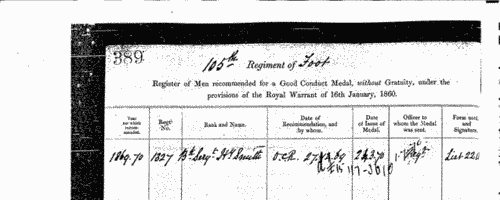
|
Research your ancestry, family history, genealogy and one-name study by direct access to original records and archives indexed by surname.
|












